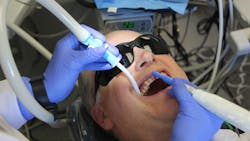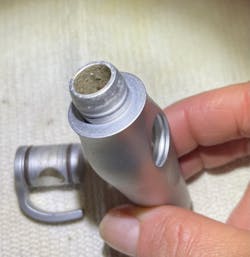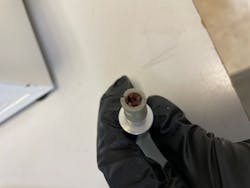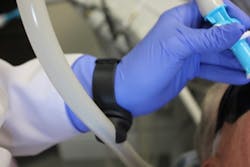I recently joked with my dentist-boss that I needed four hours per patient to get everything done. He replied, “Go for it, just make it profitable.” Well, until I can figure that out, I’m going to have to find ways to save time but still do the best for each and every patient who ends up in my chair.
One of those monumental tasks is infection control. Turning a room over takes time, and more often than not, we’re running behind—and I’m afraid to say, cutting corners. Did you run every waterline for 30 seconds? Did the disinfectant dry completely, or did you use a paper towel just as the patient was sitting down? I am guilty of all of these things, so please don’t think I’m judging. This is hard.
But when you know better, you do better, right? Despite countless hours of continuing education and internet-combing research, there is so much we just aren’t getting right. And while there are only a handful of cases linking illness to dental infection control breaches, they do exist, and science is getting better and better about tracing the source of infection. So, will the dental office be the next place on the news? I’m determined to make sure it’s not my office.
At the most recent annual conference for the Organization for Safety Asepsis and Prevention (OSAP), otherwise known as the dental infection control gurus, all the talk was about aerosols. What’s in them, how do we contain them, how worried should we be about them? The good news is we’re equipped to handle this. Through a solid infection control protocol, we’re proving that dental offices are safe. But are we living up to that protocol?
With the focus on aerosols due to COVID-19, we finally started listening to the science that says we should be using high-evacuation suction (HVE) for all aerosol-generating procedures (AGP).1 This science started all the way back in 1969.2 Yet most of us have been practicing with saliva ejectors to control fluid but remain blissfully unaware of the shower of aerosols and droplets in which we work. But do we know how to take care of our suction lines and adapters? Do we know how to implement this into our workflow?
Of course we do, right? Just run the lines daily and wipe the adapters between patients?
Not so fast …
Have you ever seen the instructions for use (IFU) for your HVE and saliva ejector adapters? I’ve been an RDH for more than 25 years, and I never looked. Apparently, we’re supposed to be taking these things apart! Some IFUs say weekly, some daily, and others between every patient. An unpublished internal study conducted by the Veterans Administration (Jim Langeloh, Dove, personal communication, June 27, 2021) showed that it would take 11 minutes for one staff person to disassemble, scrub, process, and then reassemble each adapter. I need to save time, not add more!
Another informal study by Pat Pine3 published in RDH magazine showed some shocking results on how clean—or not—our suction adapters are. In 2017, Pine went into multiple offices and swabbed 212 adapter valve surfaces after room turnover. Not a single adapter passed! Think of all the nooks and crannies in that device. Are we really getting the lever clean or all the swivel parts? It appears not.
As a hygienist on a mission, I set out to reprocess all of the adapters in the office. If you have never done this (like I hadn't), it will take WAY longer than 11 minutes each because those adapters are glued together with a Gorilla Glue-like biofilm. Once I removed the adapter from the hose, I had to soak it in hot water for about an hour to loosen the sludge. When I was finally able to get the pieces apart—whoa Nellie, that was gross (figure 1). And just to think that is right next to our patients’ faces.
Additionally shocking was our tubing. I’ve had the good fortune to move around the world with my husband’s military career, so I’ve seen a lot of dental offices. There are some offices where the tubing is soft and pliable and others where it’s stiff and rigid. Well, that’s not different brands of tubing—that’s the difference between new and old tubing. After years of disinfectant wipes and buildup inside the hoses, they start to stiffen and lose their elasticity (figure 2). I never paid attention to that; I just thought it was different tubing!
If lines and adapters are gunky, what about backflow?
According to the Centers for Disease Control (CDC), backflow happens when previously suctioned fluids present in the suction tubing flow back into the patient’s mouth. Backflow can happen when:
- There’s pressure in a patient’s mouth (a result of their closing their lips and forming a seal around the tip of the ejector) that is less than that in the saliva ejector (similar to how liquid flows back into a cup after drinking through a straw).
- The suction tubing attached to the ejector is positioned above the patient’s mouth.
- A saliva ejector is used at the same time as other evacuation (high-volume equipment).4
Most of us know by now not to let our patients close their mouths on the saliva ejector. But some patients can’t be deterred from it. Now that I know what’s been lurking in that adapter and tubing, I have to do more to ensure patients aren’t exposed to anything potentially harmful.
So what can we do?
I just can’t add more to my clinical day. Did I mention I’m tapped out? While I love the idea of reprocessing the adapter and running the suction lines between each patient, it’s just not going to happen. Thankfully, Dove Dental makes an affordable and functional disposable HVE and saliva ejector valve and tip. So no stress about whether you got that adapter thoroughly disinfected; you just throw it away and move on. Time-saver! This product is not only superlight, reducing strain on my nondominant hand; the HVE also has a wide flair tip that captures aerosols and fluids and is an excellent retractor that doesn’t suck up my patient’s cheek!
The Dove Dental products also come with a built-in backflow preventer, so when that patient closes their mouth, despite what you tell them, you can be at peace knowing whatever might be lurking in those lines isn’t coming back at them.
What about the hoses?
When I finally got the adapters off the hoses, I found them occluded with prophy paste and gunk around the inside edges, even though we’re great about running our lines. I’m so glad I was wearing appropriate PPE! I called our supplier and ordered new tubing right away. The fantastic thing is, to replace all the suction tubing in our office of four operatories it would cost less than $100 for basic tubing. And we chose to upgrade to ultralight A-flexx tubing for our HVE lines for just a little bit more. It took me all of 20 minutes to install the new tubing across the office.
While I’ve never seen any recommendations for how often suction tubing should be changed, after this adventure, I’d say we’ll be doing it every few years, if not every year. I’m thrilled to report our suction improved, and I have to think it’s better for our vacuum pump. This was a definite added bonus to tout to my dentist (who no doubt watched this adventure thinking, “And there she goes again”).
Using the Dove HVE with a CordEze bracelet to reduce drag and changing out my suction tubing to the ultralight HVE A-Flexx tubing (figure 3), I am finally ready to adapt to the HVE recommendations for AGPs. Now I’m saving time and protecting my health and my patients’ health. Next up: how to make the four-hour appointment profitable!
Editor's note: This article appeared in the September 2021 print edition of RDH.
References
1. Harrel SK, Molinari J. Aerosols and splatter in dentistry: a brief review of the literature and infection control implications. J Am Dent. 2004;135(4):429-437. doi:https://doi.org/10.14219/jada.archive.2004.0207
2. Micik RE, Miller RL, Mazzarella MA, Ryge G. Studies on dental aerobiology. I. Bacterial aerosols generated during dental procedures. J Dent Res.1969;48(1):49-56. doi:10.1177/00220345690480012401
3. Pine P. A case study of evacuation valves reveals hidden danger to dental patients. RDH. November 1, 2017. https://www.rdhmag.com/patient-care/article/16409704/a-case-study-of-evacuation-valves-reveals-hidden-danger-to-dental-patients
4. Saliva ejector and backflow FAQs. Centers for Disease Control and Prevention. Updated March 3, 2016. Accessed June 26, 2021. https://www.cdc.gov/oralhealth/infectioncontrol/faqs/saliva.html
Amanda Hill, BSDH, RDH, a practicing dental hygienist, industry educator, and key opinion leader, is passionate about the dental industry. She is a speaker, award-winning author, and host of the Your Dental Top 5 podcast. A member of the advisory board for RDH magazine and OSAP’s Infection Control In Practice Editorial Review Board, Amanda strives to make topics in dentistry accurate, accessible, and fun! She can be reached at amandahillrdh.com and [email protected].
About the Author

Amanda Hill, BSDH, RDH, CDIPC
Amanda Hill, BSDH, RDH, CDIPC, is an enthusiastic speaker, innovative consultant, and award-winning author who brings more than 25 years of clinical dental hygiene and education to dentistry. Recipient of ADS’s Emerging Infection Control Leader award and an active participant with the advisory board for RDH magazine, DentistryIQ, and ADS’s Infection Control in Practice Editorial Review Board and membership committee, Amanda (also known as the Waterline Warrior) strives to make topics in dentistry accurate, accessible, and fun. She can be reached at [email protected].



